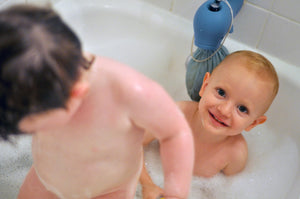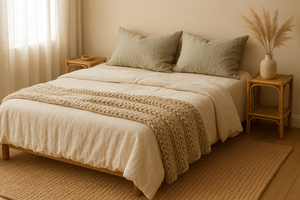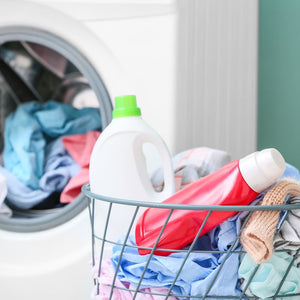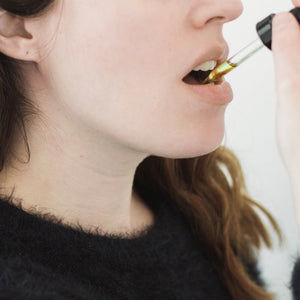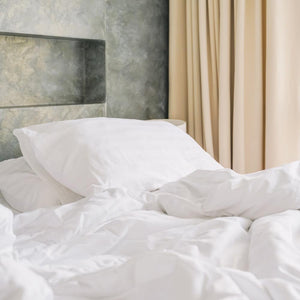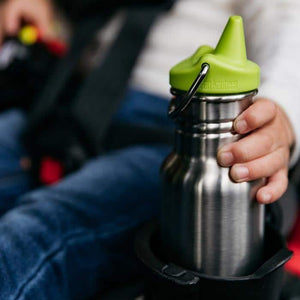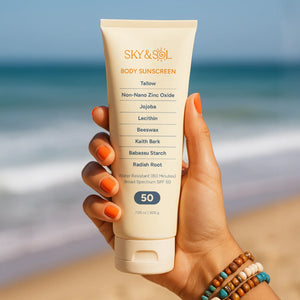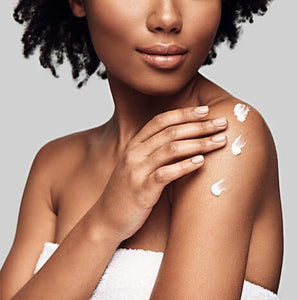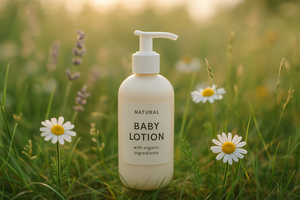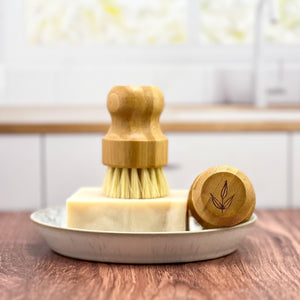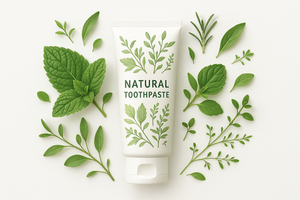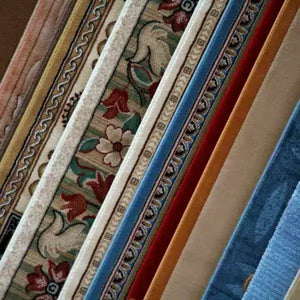Bottom Line: The 6 Safest Non-Toxic Sofa Brands
If you’re looking for the best non-toxic sofa brands, these six are the best of the best. You’ll read all about each of them further down, but if you want to just buy, please make note of some exclusive discounts in the list below.
- EcoBalanza – 10% off for our readers. Email us to order.
- CleanSleep – Thank you for supporting our store
- Medley – 5% off with code GIMME5
- Kalon Studios – 7% off for our readers. Email us to order.
- Savvy Rest
- Cisco – 15% off for our readers. Email us to order.
Non-Toxic Sofa Materials
When you’re evaluating upholstered furniture brands, here are some things to look for:
- Cushions. The most sustainable materials for cushions and padding are natural latex, cotton, down, and wool. Polyurethane foam isn’t Good Stuff, strictly speaking, but we are okay with it in sofas. You’ll want to avoid cushions with fabrics that have been sprayed with stain-resistant treatments, as these usually contain PFAS.
- Frame. Opt for solid wood construction instead of composite wood products. You can learn more about what to look for in wooden furniture, including sofa frames, in this post.
- Finishes. Look for sofas made with glues, stains, and varnishes that are zero or low-VOC.
- Certifications. The Global Organic Textile Standard (GOTS) and the Global Organic Latex Standard (GOLS) certifications ensure that the fabrics and latex used in your sofa meet the strictest standards for health and sustainability. Poly-based foams should have CertiPUR certification, which at least limits the VOCs emitted. GreenGuard Gold certification is easier to achieve than GOTS or GOLS, but still better than nothing! You can learn more about these certifications in our mattress guide.
Flame Retardants in Furniture
You’ve probably read–on this website and elsewhere–that your sofa is bad for your health in large part because of the flame retardant chemicals it may contain. Indeed, if your sofa was manufactured before 2014, it almost certainly contains one of the following flame retardants:
- Polybrominated diphenyl ethers (PBDEs) are found in mattresses, electronics, and cars, in addition to the foam of sofas. PBDEs are associated with hormone disruption and neurodevelopmental delays, including lowered IQ . The European Union has banned the use of PBDEs in electronic devices. Studies show that children in the United States have higher levels of PBDEs than adults do. Oh, and here’s the kicker: they don’t even work very well at stopping fires.
- Firemaster 550 is made with bis(2-ethylhexyl) tetrabromophthalate (TBPH). Yes, you saw that word in there: phthalate. TBPH is nearly idential to DEHP, the phthalate banned in children’s products due to evidence of carcinogenicity and developmental toxicity.
- Chlorinated tris is the chemical that was removed from children’s pajamas in the 1970s because it was shown to cause cancer.
Good News on Flame Retardants!
Things changed for the better nine years ago. The flammability standards enacted in 2014 can be met WITHOUT the use of the toxic chemicals I just described! To be clear–the law does not BAN the use of the chemicals; it just renders them unnecessary. Look for the TB117-2013 label on sofas and pillows, which suggests that the item meets the standards without fire retardants.
Felix, 4, on a Cisco sofa that we still have today, 10 years later!
How to Reduce Your Exposure to Flame Retardants
This guide is intended to help you select the safest sofa or upholstered chairs. However, if you’re not yet ready to plunk down thousands, here are some other steps to limit your exposure to older furniture in your home.
- Keep foam enclosed. Be sure to mend any rips in your sofa or chairs that might allow chemically-treated foam to be exposed, and don’t remove cushion casings to launder.
- Upgrade your mattresses. If replacing your own mattress is out of the question, consider upgrading just the mattresses for your children. Many of my clients think their crib mattresses are okay if they are old because they have “already off-gassed.” In fact, as the foam degrades, more PBDEs and other chemicals may be released. Get help choosing a truly non-toxic mattress with our Safe Mattress Guide.
- Ditch your broom. Flame retardants accumulate in household dust, and sweeping puts plumes into the air. Instead, use a vacuum or wet mop to banish dirt and toxins. Invest in a HEPA-sealed vacuum that really traps toxins.
- Invest in a robust air filter. We like (and own) Austin Air filters, which employ HEPA, activated carbon, and zeolite, a mineral with superior ability to trap toxic gases and odors such as formaldehyde, ammonias, and carbon monoxide.
- Eat more plants. Unfortunately, even though these chemicals are being phased out, they will continue to persist in our environment for years. The number one food source of PBDEs is poultry fat. The lowest levels of a variety of toxins–including flame retardants–are found in plant-based foods, so if you substitute beans for chicken a couple of times a week, you’ll reduce your exposure.
What Other Toxins Are in Sofas?
Unfortunately, flame retardants aren’t the only problem with upholstered furniture.
The glues and finishes on wooden legs can contain formaldehyde. Even without a chemical bath, polyurethane foam is a petroleum-by product that releases VOCs.
Anything that is wrinkle or stain-resistant from a treatment like Scotchguard should be avoided. Back in the day it Scotchguard contained a noxious chemical called PFOS–which is not only terrible for the environment but also linked to cancer, hormone disruption, and immune system dysfunction. Scotchguard agreed to phase out PFOS and has replaced it with PFBS. Overall, PFBS seems safer, as it has a shorter half-life and accumulates in our bodies at a slower pace. I remain skeptical as safety studies are still lacking.
Leather is another sofas material that is frustratingly problematic. Leather itself is not inherently toxic, but the tanning process used to turn animal hides into leather can involve the use of chromium, formaldehyde, and various solvents. Additionally, some leather products may be treated with flame retardants or stain-resistant coatings or phthalates. Chrome-free leather is acceptable, in my opinion, and better yet is leather that specifies that it is chrome-free and vegetable dyed. The two brands I know of that make this kind of leather furniture are Medley and EcoBalanza, both of which you can read about below.
Are there other potentially non-toxic sofa brands you want to know about? Comment below.
If you’d like to see all of the upholstered furniture in my own home, I give you a little tour here:
Stay sane,
Note: This article contains affiliate links or sponsored content, which means that if you make a purchase, we may earn a commission. We only recommend products that meet our strict standards for non-toxicity and that we use (or want to use!) ourselves. Thank you so much for supporting the brands that make Good Stuff!
Tags:Furniture & Decor,
guide





















